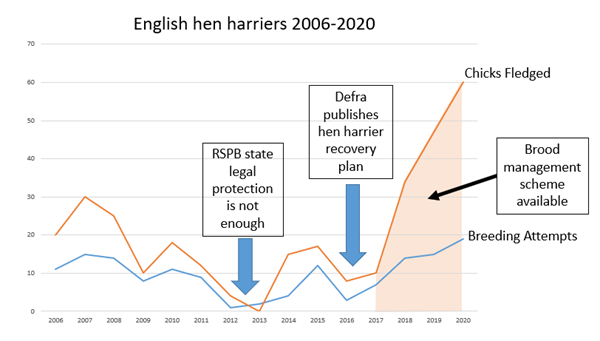By Andrew Gilruth, GWCT Director of Communications
When it came to finding solutions to wildlife conflict, Scotland has been a world leader – until now. It was home to the most ambitious large-scale moorland raptor trials in the world. However, lessons learnt have not been developed and Scotland now plans to license grouse moors in the hope that this will somehow end the conflict between raptors and grouse shooting.
In doing so it has bypassed both the recommendations of the expert group it commissioned to investigate licensing, and the 20 years of trials on Langholm Moor – which it helped fund. Suggestions that there will be further constraints on muirburn also fly in the face of the available evidence.
The first ten-year study of the driven grouse moor at Langholm proved there can be a wildlife management conflict between the grouse moors and their raptors. It’s this conflict which can lead to the illegal killing of raptors.
So, with funding from the RSPB and others, the second ten-year study at Langholm tested if diversionary feeding might resolve this conflict – and so the illegal killing. It failed. At no stage did anyone suggest the conflict could be resolved through introducing a licensing system – it’s eminently not a practical solution to the raptor conflict, indeed it could be exacerbated.
Lessons from Langholm encouraged England to embark on trials of an entirely different approach to resolving the conflict – the hen harrier Brood Management Scheme (BMS). The early results are promising.
It’s modelled on a conservation technique, successfully used in France, to discourage arable farmers from deliberately or recklessly killing Montagu's harriers, which nest in their fields. It works so well in France that they are still using it 20 years later – it removes the conflict and the illegal killing stopped. In England trials are in their early stages but the number of hen harrier chicks fledged has grown significantly.

In contrast the Scottish Government has chosen to constrain land management rather than support it with practical options. This is despite the advice of their own commissioned review into several management issues and advice on licensing.
The report lists (see pages 53-56) the nine advantages and thirteen disadvantages of licensing, and it’s easy to see why the group was so cautious about licensing. It recommended that licensing should be held in reserve and implemented in five years’ time only if other reasonable conservation management options were not acted on. Professor Alan Werritty, the review group’s chairman, has publicly defended this position and it’s easy to see why if you read the report’s findings.
The report estimated that there are just 120 grouse estates left in Scotland. This reinforces what we know about loss of heather – over 40% loss of this habitat since the Second World War. Many grouse moors have been replaced by farming or forestry – to the detriment of many ground-nesting species.
These losses are alarming. For example, around Muirkirk & North Lowther in south-west Scotland, golden plover numbers dropped by 84%, lapwing by 88% and curlew by 61%. Once these priority species lose their open habitat, they face effective local extinction.
Adding yet more red tape on those best placed to preserve and maintain this globally important open habitat is not free from consequences. If Scotland loses yet more grouse estates, we risk losing more of this increasingly rare yet iconic moorland habitat, the species that depend on it, and the social and economic life that goes with them.
Those publicly claiming that licensing is an obvious way to end the illegal killing of raptors and that restricting muirburn will store more carbon have simply misrepresented the situation. The expert group decided that the arguments for and against licensing were finely balanced and recommended that everyone from government to gamekeeper should work to improve moor management with new approaches. The review was right - wildlife management needs solutions, not another layer of bureaucracy.
FURTHER READING: Statement from GWCT Scotland on Scottish Government announcement on Grouse Moor Management Report >